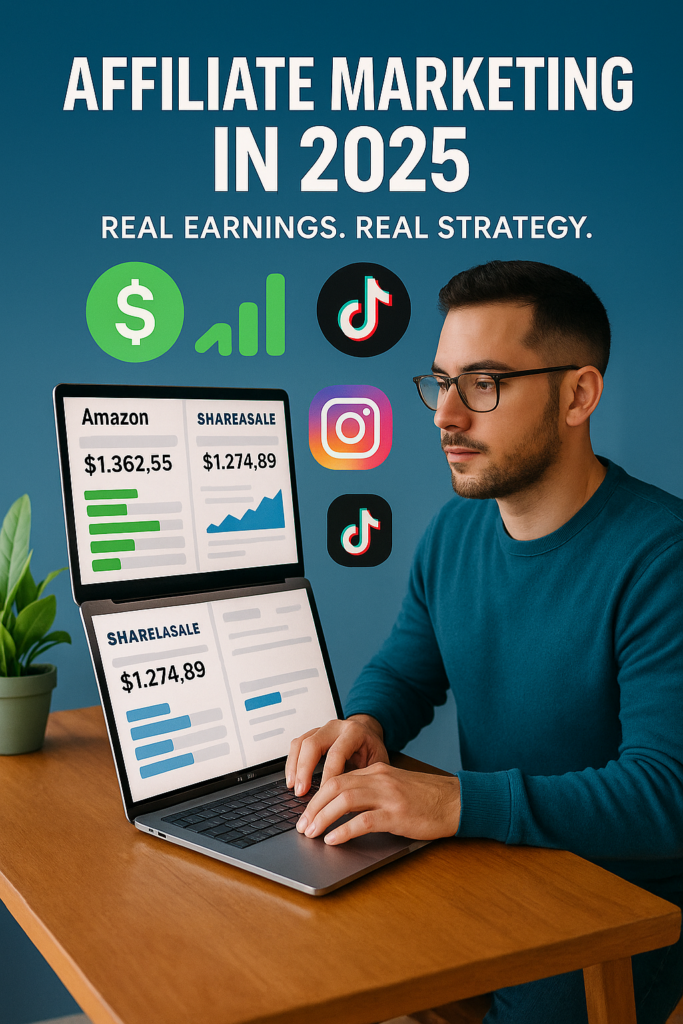Let’s Talk: Is Affiliate Marketing Still Worth It?
If you’ve ever thought affiliate marketing was dead, overhyped, or just not for you—I get it. I used to think the same. But the truth is, affiliate marketing is still alive and well in 2025. It’s just changed. The old spammy tricks don’t work anymore, but if you’re willing to create value and play the long game, there’s serious money to be made.
In this post, I’ll break down exactly how I (and others like Adam Enfroy) are making money with affiliate marketing—and how you can get started the right way.
So, What Is Affiliate Marketing—Really?
Affiliate marketing is pretty straightforward: I recommend a product or service I trust. When someone clicks my link and makes a purchase, I earn a commission. No need to create my own product, handle shipping, or deal with customer service.
Here’s the process:
- I join an affiliate program.
- I get a unique tracking link.
- I promote the product on my blog, YouTube, email list, etc.
- I earn when someone buys.
Sounds simple, right? It is—but only if you build real trust and offer real value.
Yes, It Still Works (If You Do It Right)
Affiliate marketing still works in 2025 because:
- People are buying online more than ever.
- Good content builds trust.
- Affiliate programs have gotten better—higher commissions, better tracking.
- You can start with very little upfront investment.
I personally use platforms like Impact, ShareASale, PartnerStack, and direct affiliate programs from SaaS companies.
How Adam Enfroy Turned Affiliate Marketing into a Million-Dollar Business
When I was starting out, one of the people who really inspired me was Adam Enfroy.
He was just a digital marketing guy who launched a blog in 2019. But instead of treating it like a hobby, he treated it like a business—and it paid off big time.
Here’s what stood out to me:
- He focused on high-paying affiliate programs like ConvertKit and Bluehost.
- He published long-form, SEO-driven content (think reviews and tutorials).
- He scaled fast by outsourcing content and guest posting.
- Eventually, he added digital products and coaching.
Within two years, he was earning over $100,000/month—all from affiliate marketing. Today, he runs a 7-figure business teaching others how to do the same.
What I learned from Adam? You don’t need to be flashy. You need a system, consistency, and a focus on helping people solve real problems.
How I’d Start from Scratch Today (Step-by-Step)
Step 1: Pick a Niche You Can Commit To
I chose a niche I cared about—something I could write about without getting bored. You want a niche with demand, good affiliate programs, and ideally, something you’re interested in.
Hot niches in 2025:
- AI tools and software
- Online business and remote work
- Health, fitness, or biohacking
- Personal finance and investing
- Digital education or side hustles
Step 2: Join Affiliate Programs That Pay
Look for:
- Recurring commissions (e.g. SaaS products)
- Programs that pay $50+ per sale
- Trustworthy brands you’d use yourself
Don’t chase every program—pick a few that really fit your audience.
Step 3: Create Content That Actually Helps
Here’s the thing—I never write just to “sell.” I write to solve problems. That’s how you earn trust, clicks, and commissions.
Content that’s worked for me:
- Product comparisons (Tool A vs Tool B)
- Honest reviews
- How-to tutorials
- “Best of” lists
Blog posts and YouTube videos both work—go with whatever you’re most comfortable creating consistently.
Step 4: Get Traffic (Don’t Rely on Luck)
Your content needs eyeballs. I focused on:
- SEO (search traffic takes time, but it compounds)
- Pinterest (for blog posts)
- TikTok or YouTube Shorts (for quick reach)
- Email list building (huge long-term ROI)
Once your content is ranking or getting shared, that’s when affiliate income becomes passive.
Step 5: Track What’s Working
I use Google Analytics and affiliate dashboards to see:
- What posts bring the most traffic
- What links people click
- Which products actually convert
I double down on what works and cut what doesn’t.
Mistakes I Made (So You Don’t Have To)
- Promoting products I didn’t actually use
- Expecting fast results
- Publishing low-quality, generic content
- Ignoring email list building early on
Trust me—if I had just focused on value and email from day one, I’d have scaled even faster.
Final Thoughts: Start Small, Think Long-Term
Affiliate marketing in 2025 isn’t dead—it’s mature. The quick wins are gone, but real opportunities are everywhere if you’re willing to be helpful, honest, and consistent.
You don’t need 10,000 followers or a huge budget. You need:
- A niche you care about
- A plan to create content
- A few solid affiliate programs
- A willingness to learn as you go
That’s exactly how I started—and if you stick with it, you could be the next success story like Adam Enfroy.
